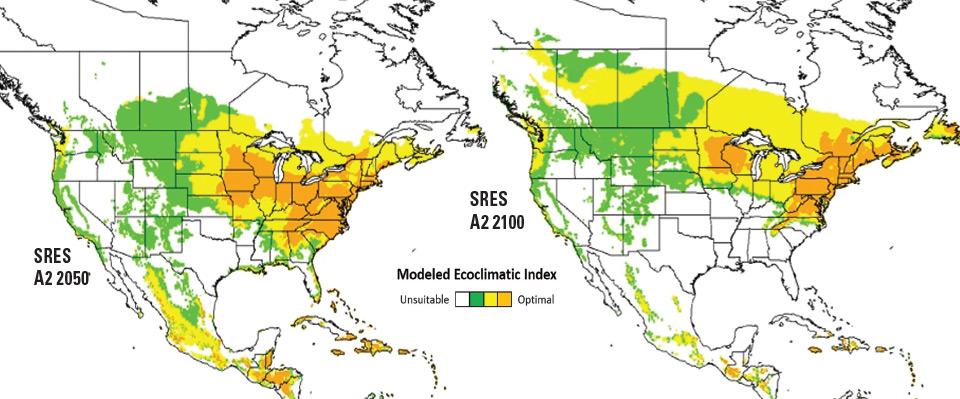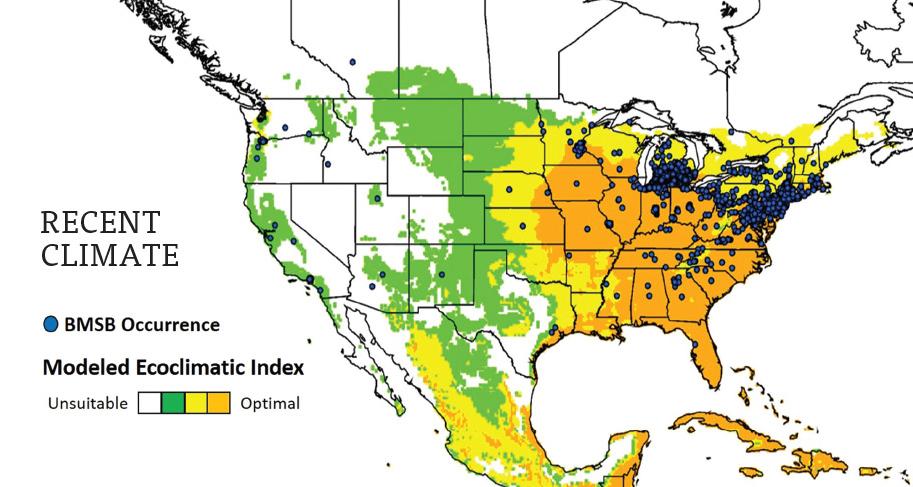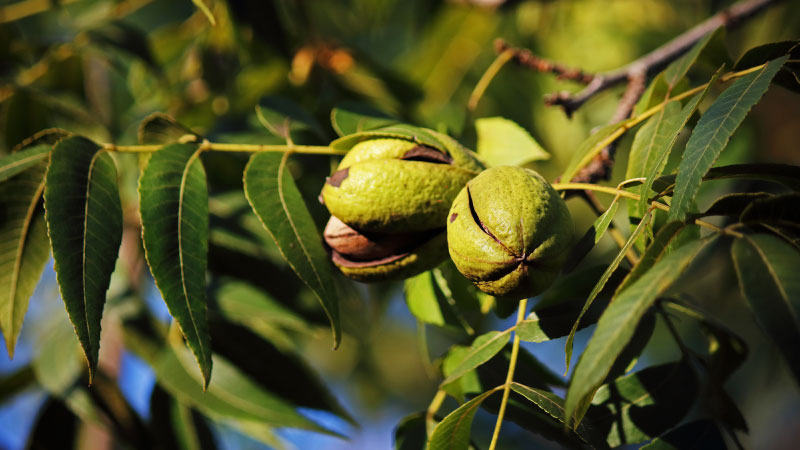Climate Models Show Brown Marmorated Stink Bug’s Growing Range of Destruction

The probability of brown marmorated stink bug occurrence under the SRES A2 emission scenario for 2050 (left) and 2100 (right) in North America.
(Source: Erica Kistner 2017, in Environmental Entomology)
In less than the 20 years since its initial North American detection, the invasive brown marmorated stink bug (BMSB), Halyomorpha halys, has quickly emerged as a severe horticultural pest in the U.S. In its native range of East Asia, this insect is considered a minor pest of fruit trees with occasional outbreaks. However, in the U.S., this pest is able to reach economically damaging densities due to a combination of factors including favorable climate, a lack of natural enemies, and an abundance of suitable host plants. To date, this pest has been detected in 44 states, with severe agricultural problems reported in nine states and minor agricultural issues reported in 12 others.
To make matters worse, the changing climate is expected to exacerbate agricultural losses from insect pests like brown marmorated stink bug by 1) expanding their geographic ranges, 2) reducing winter die-offs, and 3) increasing the number of generations produced per year. In an article recently published in Environmental Entomology, I simulated the potential distribution and abundance of BMSB under future climate scenarios for the years 2050 and 2100 using a process-oriented bioclimatic niche model. My results indicate that crop losses from BMSB in Northern states may increase as rising temperatures, especially in the winter, will likely enable BMSB to further expand its range northward as well as enhance BMSB survival and reproduction.

Brown marmorated stink bug modeling shows the potential for further range expansion across the U.S., particularly in the Central and Southern states. The blue circles designate recorded BMSB occurrences.
(Source: Erica Kistner 2017, Environmental Entomology)
Study Parameters
Model parameters describing brown marmorated stink bug responses to climatic conditions were inferred from its known geographic distribution, as well as experimentally derived temperature and moisture preferences, reared under controlled laboratory conditions. Gridded climatological datasets with a spatial resolution of a little over half a square mile were used to map potential BMSB distribution under the following three scenarios: recent historical climate data from 1951-2000 — centered on the accepted climate comparison baseline year, 1975 — and projected climatic conditions under the SRES A2 “worst case” emission scenario for the years 2050 and 2100.
Another Generation?
Overall, the model’s BMSB range projections indicate the potential for further expansion across the U.S., particularly the Central and Southern states.
Projected rising winter minimum temperatures would enable BMSB to expand its range northward throughout much of the Pacific Northwest, Midwest, and Northeast. Future projections also indicate BMSB could undergo an additional generation per year in the major apple-growing regions of New York, Pennsylvania, Michigan, and Washington by 2050. Under current conditions, in Northern U.S. regions, BMSB is only able to complete one full generation and a partial second-generation per year. In addition, our neighbors to the north, particularly the provinces of Ontario and Québec, likely will experience increased BMSB outbreaks as warming winter temperatures enable BMSB to further expand its range across Canada.
Fortunately, there is some good news as growers in the Southern states, including California, will likely see decreased BMSB activity and subsequent crop damage as summer temperatures continue to rise above this insect’s preferred temperature range. The SRES A2 scenario’s projected daily mean and maximum temperatures in July-August of 2050 will be well above BMSB’s optimal temperature limit of 77°F, which should reduce BMSB growth and reproduction in Southern states. Under this extreme scenario, suitable BMSB range in many Southern states would be eliminated completely by 2100.
Future Management
It is important to keep in mind that these model simulations are only indications of the possible changes in future BMSB population dynamics in light of future climate projections. Therefore, these simulations should not be viewed as predictions of future BMSB distribution and abundance. Regardless of the uncertainties associated with these scenarios, growers in the Northern portions of the U.S. should continue to carefully monitor BMSB populations as future climate projections indicate the possibility for increased BMSB outbreaks in those regions. ●










